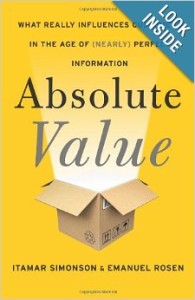
Itamar Simonson and Emanuel Rosen
This book was a gift. The subtitle (What Really Influences Customers in the Age of (Nearly) Perfect Information) overcame my reluctance and I gave it it a quick read, which is all it deserves. This is a formula book, and as one reviewer notes, would have been just fine as an article. The “innovation” in the book is the discovery that brand and prior experience are less relevant today to purchasing decisions that are now heavily influenced by up to date social commentary and readily available peer reviews.
At one level I find the book interesting as a quick once over of the obvious. At another level I am quite disappointed. There is nothing in this book about true cost economics or open source. If you want to be pretentious and talk about Absolute Value, it would help if you actually had a clue that Absolute Value includes virtual water, virtual fuel, virtual child labor, and virtual tax avoidance, among other things.
I appreciate the discussion of how false reviews and paid reviewers are losing ground to better systems for policing such abuses, and I am interested when they discuss the failure of most market research, which focuses on past experience and conventional concepts.
The importance of corporate monitoring of social media for all mentions of all of their products is presented in a useful manner. I particularly like the examples in relation to rapid recognition of flaws from specific production lines — this is about feedback loops.
The book ends weakly with a few examples of sites such as Goodguide, Decide.com, and BrightScope.
Best wishes to all,
Robert David STEELE Vivas
INTELLIGENCE for EARTH: Clarity, Diversity, Integrity, & Sustainability



